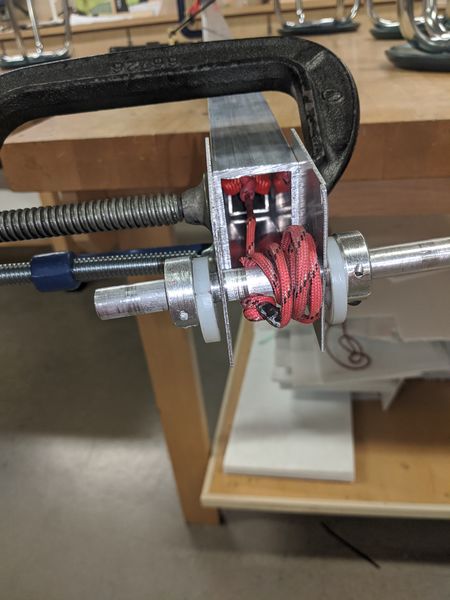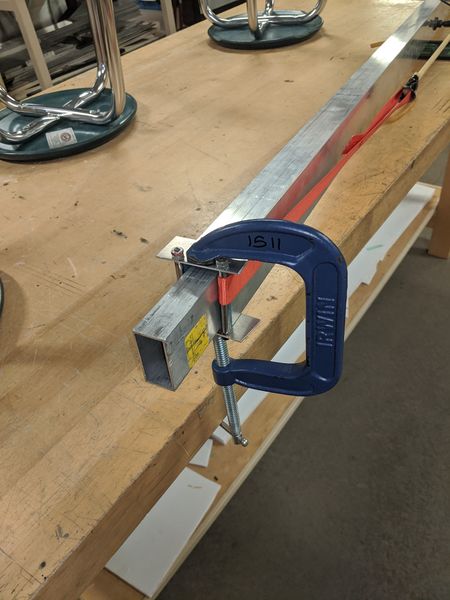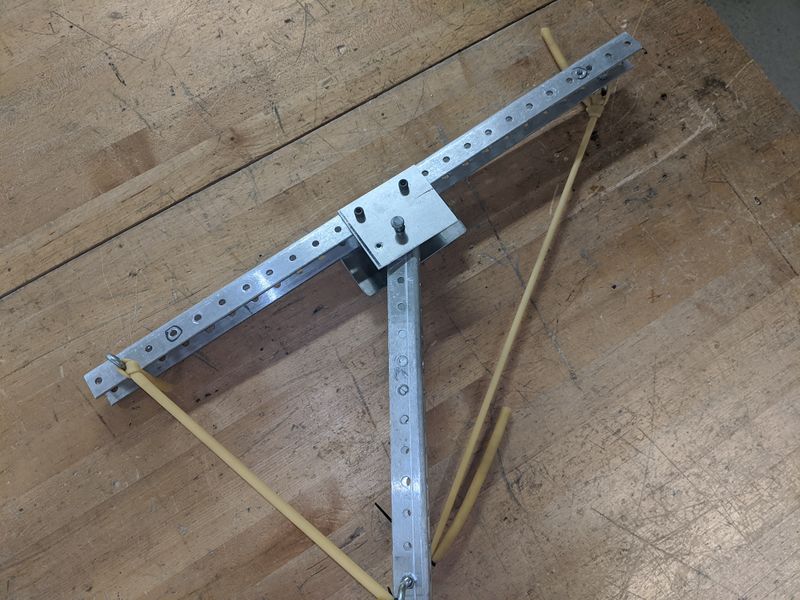2020:Hang: Difference between revisions
No edit summary |
No edit summary |
||
| Line 209: | Line 209: | ||
if<s>you are editing this between 7:05-7:25 or 12:00-12:45, your contributions can and will be deleted :P</s> edit away | if<s>you are editing this between 7:05-7:25 or 12:00-12:45, your contributions can and will be deleted :P</s> edit away | ||
</div> </div> </div> </div> </div> </div> | </div> </div> </div> </div> </div> </div> | ||
== 1/16/2020 == | |||
Attendance: probably someone | |||
Do not edit this page, this meeting hasn't happened yet | |||
Revision as of 09:34, 16 January 2020
Team Leads
Alex F. & Nicole L.
Pros and Cons
Pros and Cons of Each Design Option
| Telescoping Frame Design | Telescoping Arm | ||
|---|---|---|---|
| Pros | Cons | Pros | Cons |
| More Stable | Heavier | Lighter | Difficult to maintain |
| Fits within the allotted space better | Wider | Thinner | Having 2 hooks is harder * |
| Easier to maintain | Harder to add self balancing mechanism | Easier to add self balancing mechanism | Less stability |
| Easier to have 2 hooks | Single motor | ||
| Single motor | |||
Explanation
- Pros of telescoping frame
- More stable
- Due to having 2 arms that are connected, it is going to be more stable than a single arm.
- Fits within allotted space better
- We have a lot of space side to side, but front to back we only have 1-7 inches max. Since each stage can be the same thickn ess as the other ones (since they don't have to fit inside each other), the first stages can be thinner than the ones of the telescoping arm.
- Easier to maintain
- Since the stages are next to each other, instead of inside each other, it will be much easier to fix between matches.
- Easier to have 2 hooks
- Since the frame will already have 2 sides, it will be very easy to put a hook on the top of each side of the third stage.
- Single motor
- Despite having two sides, the frame is still extended and retracted with a single winch in the middle of the two sides. Thereforem, it will only require a single motor (compared to a deplloyable hook which would likely require 2).
- More stable
- Cons of telescoping frame
- Heavier
- Since it has two sides, it will require more material than the telescoping arm, making it heavier.
- Wider
- The design has two sides, each of which will be three tubes of metal side by side. However, the telescoping arm will only require three total, which will be inside of each other.
- Harder to add self-orienting mechanism
- The self-orienting mechanism we protoyped really only works well with a single arm. It could be modified a bunch to work for two sides/a wider arm, or scaled up a bunch to work as it is.
- Heavier
- Pros of telescoping arm
- Lighter
- It's only a single arm, so it will require less material.
- Thinner
- The telescoping arm will only have 3 tubes of metal, with the last two being inside the first. Therefore, the mechanism will ony be as wide as the first stage (not including the winch).
- Easier to add self-orienting mechanism
- The self-orienting mechanism that we prototyped is designed to work with one arm, meaning that adding it to the end of the telescoping arm would not be too dificult (compared to the telescoping frame).
- Single motor
- This prototype also only requies a single motor, since it only has a single winch in the center.
- Lighter
- Cons of telescoping arm
- Less stable
- Since it would be a single arm anchored at a single point, it would be less stable and more prone to swinging around on the bar after climbing.
- Difficult to maintain
- Since the stages are inside each other, it would be much harder to repair between matches (see 2016).
- Harder to fit 2 hooks
- The center support in the middle of the bar is 3 inches wide. This makes a single telescoping arm with two hooks even less practical, as it requires the third (and thinnest) stage to be wide enough to fit 2 hooks with 3 inches in between. Stage 2 will then need to be even wider, and stage 1 will need to be even wider than stage 2. This means the telescoping arem would have to be very big to allow 2 hooks, adding more weight and potentially making it hharder to fit inside of the allotted 5 inches or so. This problem would be solved by putting the self orienting hook mechanism on the end though.
- Less stable
Prototyping 1/5/2020-1/11/2020
Overview: Based on initial team brainstorming and sketching, as well as the information from Strategy Subteam, we determined to prototype:
- Telescoping arm
- We are also prototyping a self-balancing mechanism.
- Deployed hook
- Hook designs
Observations: We observed the following over the course of prototyping:
- All prototypes work well.
- it juust works
Decisions:
- We will have two telescoping arms located on the DB frame at the center of gravity
- We will not attach parallel to the bar, we want to come at it perpendicular (drive into it)
- We have decided on the profile of the three stages (I guess not, now it's 2", 1.5", 1"?)
- We will have two hooks on a self-balancing mechanism.
- We have decided on the motors we are using (Neos)
Need to do:
- Continue to work on Hook designs, figure out how it will be mounted to the self orienting hook mechanism.
- Finalize the mount design
- We need to know where the center of gravity is so that we can see if we can mount the arms there.
- We need to make sure that nothing will get in the way of a crossbar between the two arms.
- We need to look into the height more to see what our soft height limjit will be (shooter) or if it will just be the 45" limit, and how that will affect the height of the arms and our design. Currently, the heights we are using assume the telescoping arm is located 4.6" above the ground. Currently, 27" allows us to reach above the maximum height of the bar, while still being under the 45" limit.
- Limit and remove any pinch points with the straps.
- Find new stock that gives us more room to mount but is still light
- Figure out how low each of the stage goes
- Reconfigure mount to be more sturdy but still fit in the alloted space
- Reduce height of the retracted mechanism so that it doesn't interfere with the shooter at all.
- Change the assembly to reflect the updated profiles of the tubes that have the new dimensions that give us 1/8" between each section
 Telescoping arm Winch prototype
Telescoping arm Winch prototype
 Telescoping arm prototype other end
Telescoping arm prototype other end
Design
1/11/2020- As a subteam (minus Ben), we decided on a design that has two telescoping arms on the center of gravity of the channel on the DB. The mechanism is made up of square/rectangular tubing with a constant force spring that is wound out when the arm is retracted and winds up back to a coil when the arm extends. The force the spring needs to lift is only the weight of the arm, which we estimate to be about 10 lbs per arm. We will need a total of 8 constant force springs with 4 on each arm to allow the arm to extend and one motor to drive a winch which will keep the arm retracted during all the match except endgame, where the winch will drive the arm back up. We also decided that the only sensor we will need is an encoder on the motor. Since Neos have encoders built in, and we might use a Neo, we might not need to add anything. According to Jeff, the encoders on the Neos are unreliable and since the encoder will be the only sensor on the entire mechanism, we should probably add another one regardless. The strap will go through the middle of the two telescoping arms and above the wheels. It will then attach to a drum on an axle, that connects the two drums together. The motor fits into this equation somehow, but I don't know.
Strap: (https://www.strapworks.com/ProductDetails.asp?ProductCode=FNW12&gclid=CjwKCAiApOvwBRBUEiwAcZGdGC9bNVgTQgranl8ih_3NK1bXtC7pBgu-UmpWWLirkfr80HY2i77UZRoCh0AQAvD_BwE) 100 ft. Red
Daily Diary
1/7/2020
5:00-9:00 Attendance: Alex F, Nate S, Nicole L, Elliot W, Nevin W, Michael N, Ben S
We re-tested the telescoping arm and designed a self orienting hook mechanism base. Tommorow, we have to finish that and adjust the surgical tubing and add hooks to the bar. We need the tape measure spring for the final telescoping arm design if we choose to follow that route (and need the actual hooks, which are being prototyped as we speak/type). We have to decide if we want 1 or 2 telescoping arms still, it depends. See robot design for pictures or will update later. Videos are not allowed, on this wiki, so more pictures.
1/8/2020
5:00-9:00
Attendance: Nicole, Alex F, Nate S, Trevor W, Ben and Christian Stoeckl
Nicole/Stoeckl: I did the calculations for where both robots would have to hang and how heavy they are to be balanced, the file is on the harris drive as "Torque for Hang NL". This spreadsheet doesn't account for only one robot to hang and doesn't take the 8 deg of allowance from being balanced. Tommorow we will have to fix that so that it can display when a robot is balanced at the center which can help us figure out if we need one arm or two arms. Tommorow we also need to figure out the force to lift the robot with one or two robots which will lead us to know what type of motors we might need. We also still need to figure out the size of the constant force spring to bring up the hook alone. We have to CAD up a scale sketch of the different arms (telescoping arm and the deploying arm at least) with it on top of the drive base so we can see how many sections we will actually need to have.
Everyone that isn't Christian/Nicole: We finished the prototype for the self deploying hook by adding a quick hook to the end. We also fixed the tensioning on the self orienting hook prototype, so that the bar is relatively perpendicular to the arm. We then tested it by having it extend, put the hook over the bar, and then retract, leaving the hook on the bar. In theory, if we had another string attached to the hook, we would then be able to winch it. We discussed the pros and cons of having multiple hooks and/or having multiple arms. We decided against coming at the bar parallel. We still need to make decisions on basically everything.
1/9/2020
5:00-9:00
Attendance: Nicole L, Alex F, Nate S, Nevin W, Ben and Christian Stoeckl
Everyone that isn't Christian/Nicole: We narrowed down the options for our endgame mechanism between a telescoping frame and a telescoping arm. We also made sketches in Inventor modeling the two mechanisms to size. We established that having a two stage telescoping arm would require an arm that starts right at the 45" height limit. We made a pro/con list for each of them to present on Saturday. We will need to start working on 3D CAD designs for the mechanism we choose Saturday.
Christian/Nicole: We fixed the previous spreadsheet for hang to include the 8 deg balance allowance, this is on the Harris Drive as "Torque for Hang NL" in the 3rd tab i believe. The concept of this spreadsheet is similar to the last with some new variables given that there is now a change on how the 8 deg will effect where you can balance given that the robots are spaced apart a changable distance and weigh a changeable weight. I also did calculations on how many times a winch would need to rotate given a changable diameter and changable height the robot needs to be lifted. I then calculated how quickly some motors we commonly use (CIMs, 775 pros, etc) would take the weight of the robot up to climb. The quickest time was for 1.3 seconds going about 70 rotations/sec (i think i dont have access to the spreadsheet right now). We also figured out the gear box ratio. The reason we did this was so that we know how many motors we need to lift the robot, whether or not that is with one arm or two, the lift mechanism will only need one motor, which helps possibly eliminate the worry about using up our motor count depending on our hook config. I think that is all the calculations and Stoecklometry™ we needed to do to get a basic understanding of the requirements to lift and balance on the hanger, so now we just need to see how the robot design meeting goes.
nicole i deleted your stuff sorry :( (its ok i fixed it-NL :) )
1/10/2020
12:00-11:59
Attendance: Alex F, Nicole L
Alex F: Reformatted and added explanation for pro/con list.
Nicole L: Readded the entry that got mysteriously deleted by an unknown force
1/11/2020
10:00am-12:00am
Attendance: Alex F, Nicole L, Nevin W, Nate S, Trevor W, Elliot W (kinda), Herr Dr. Stoeckl
We began by redoing our design after 60% of the team had an issue with it. Under the lead of Herr Dr. Stoeckl we decided on a new design containing concepts from both the telescoping arm and the telescoping frame, featuring 2 telescoping arms located on the CG. We also decided that we would eventually use a ratchet and paul combined with servo to lock the telescoping arm in place. We also made a prototype with actual constant force springs to better simulate our design. We still need to lock Nicole in the cabinet, but this time make sure that she is actually being randsomed instead of just being kidnapped.
Stoecklometry™
1/12/2020
Attendance: Alex F, Nicole L, Nevin W, Nate S, Trevor W, Dr. Stoeckl
We continued to work on CAD models for the Hang mechanism. We made a height calculator that could calculate the minimum and maximum height of the telescoping arms. We also began designing mounts for the telescoping arms, with rollers for the straps and an axle to rotate on. We also have continued work on hook designs, and completed the second iteration of the self orienting mechanism. The drum mechanism is still being worked on, and needs to be finished. We also need to finish the hook and mount designs. Liquid rubber?
1/14/2020
Attendance: Alex F, Nicole L, Nevin W, Nate S, Trevor W, Ben S
We continued to work on the CAD design for the hang mechanism. We finished the drum mechanism and assembly and put it on the drive base. We also continued to work on the mount for the first stage I think. Hook designs are still in progress. We tested the first iteration of the 3D printed hook, and the mount on the hook broke. We decided that we should use Neo motors because they run the fastest, are the lightest and the gear ratio would be reasonable. We also realized that the aluminum tubes we were going to use would not give us much room to mount the constant force springs or the nylon spacers, we are now looking for other places to buy the stock from with a size of 2", 1.5" and 1 inch with 1/16 inch thick walls. McMaster had them but thy wouldnt come in in time (6-7 weeks), so we started looking for other places that sell the stock, but we haven't finished yet. It's mostly done concept wise, just needs some detail work now. We also made a decent weight calculator, and as of right now, the hang weight is sitting at around 7.5 to 8 pounds, including the three stages, mounts, drum and shaft assembly, hooks, and motors. We still need to include a couple spacers, gears for the motors, gearboxes?, and the strap. The weight of the three stages will also likely change if we switch to bigger tubes.
1/15/2020
Attendance: Alex F, Nicole L, Trevor W, Ben S
We received new instructions from the shooter team that we need the crossbar to be under 26 inches above the drivebase. In order to reduce the height, we removed the .375 inch spacer under the mount, we reduced the height of the bars by 4 (down to 23") and we reduced the overlap of the two stages from 4" to 2". We also need to increase the height of the hooks by a lot in order to still reach over the bar when it is at it's highest. We also continued to work on the hook design and make sure that they could be mounted to the bar. We also updated the Constant Force Spring mounting plates, allowing the arms to retract further (and not be as tall).
ifyou are editing this between 7:05-7:25 or 12:00-12:45, your contributions can and will be deleted :P edit away
1/16/2020
Attendance: probably someone
Do not edit this page, this meeting hasn't happened yet
